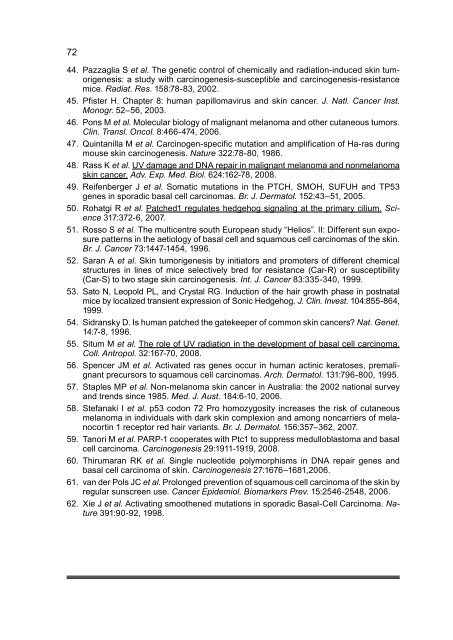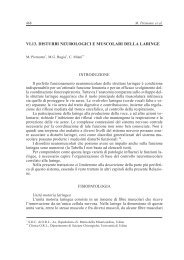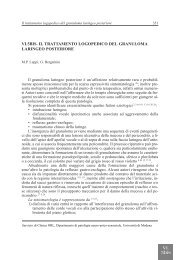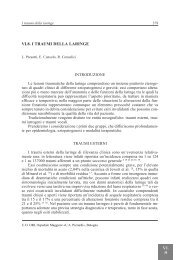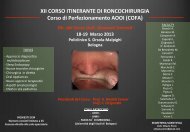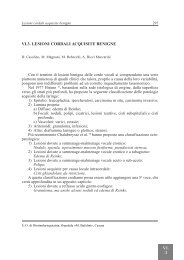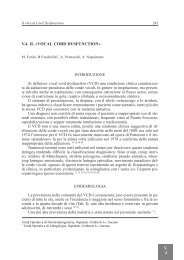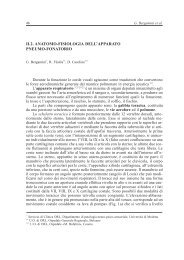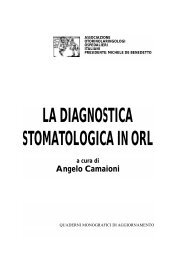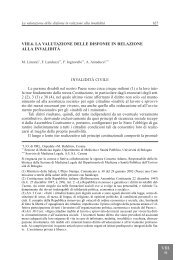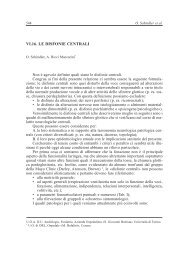- Page 1:
ASSOCIAZIONE OTORINOLARINGOLOGI OSP
- Page 5:
PREFAZIONE I carcinomi della cute s
- Page 8 and 9:
A. COLOSIMO Dipartimento di Scienze
- Page 10 and 11:
10 B. PICHI S.C. di Otorinolaringoi
- Page 13 and 14:
INqUADRAMENTO GENERALE DEGLI NMSC L
- Page 15 and 16:
Il rapporto sull’incidenza e sull
- Page 17 and 18:
ne al sole intermittente e concentr
- Page 19 and 20:
di ozono sembra dipendere dalla con
- Page 21 and 22: PRECANCEROSI CUTANEE Le precanceros
- Page 23 and 24: sia epidermica, senza la produzione
- Page 25 and 26: ma il sistema utilizza in questo ca
- Page 27 and 28: mentali, il tipo compatto, costitui
- Page 29 and 30: aggressive rispetto agli altri tipi
- Page 31 and 32: della re-escissione chirurgica, ma
- Page 33 and 34: Gli SCC sono un gruppo di tumori ca
- Page 35 and 36: All’aumento del grading corrispon
- Page 37 and 38: ma orizzontale). Nei casi nodulari
- Page 39 and 40: 5. La diffusione per via linfatica
- Page 41 and 42: 7. SCC Cutaneo estraneo a raggi Uv
- Page 43 and 44: dei margini decresce dal 2 % al % s
- Page 45 and 46: 1 . 1 . 19. 20. 21. 22. 23. 24. 2 .
- Page 47: 6. . . 9. 60. 61. 62. 63. 64. 6 . 6
- Page 50 and 51: 0 Negli ultimi cinquanta anni si so
- Page 52 and 53: 2 Una chiara ereditarietà di tipo
- Page 54 and 55: 4 In proposito, ricordiamo che il n
- Page 56 and 57: 6 1 . 1 . 19. 20. 21. 22. 23. 24. 2
- Page 59 and 60: ONCOGENESI E BIOLOGIA MOLECOLARE M.
- Page 61 and 62: ciato ai microtubuli comprendente l
- Page 63 and 64: alla scarsa efficienza dei meccanis
- Page 65 and 66: 199 ). Una maggiore frequenza di mu
- Page 67 and 68: Figura 2: Modelli murini di cancero
- Page 69 and 70: 4. CONCLUSIONI E PROSPETTIvE FUTURE
- Page 71: 22. 23. 24. 2 . 26. 2 . 2 . 29. 30.
- Page 75 and 76: Mutazioni ereditarie che predispong
- Page 77 and 78: Sindrome di Gorlin La sindrome di G
- Page 79 and 80: attiva a cascata l’espressione di
- Page 81 and 82: moderata atrofia follicolare della
- Page 83 and 84: ile del processo canceroso (Fears,
- Page 85 and 86: et al, 2004). Alcuni studi sono sta
- Page 87 and 88: teressante è la perdita di eterozi
- Page 89 and 90: temente da Saggar e collaboratori s
- Page 91 and 92: di carcinomi spinocellulari e melan
- Page 93 and 94: CONCLUSIONI Negli ultimi anni, graz
- Page 95 and 96: Hahn H, Wicking C, Zaphiropoulous P
- Page 97 and 98: Molès JP, Moyret C, Guillot B, Jea
- Page 99 and 100: Bapat B, Xia L, Madlensky L, Mitri
- Page 101: 101 chemical-carcinogen-induced ski
- Page 104 and 105: 104 caratteristiche, denominate che
- Page 106 and 107: 106 involucro intracellulare corneo
- Page 108 and 109: 10 sma contenente filamenti paranuc
- Page 110 and 111: 110 un reticolo tridimensionale che
- Page 112 and 113: 112 tessuto adiposo. Tale struttura
- Page 114 and 115: 114 La corteccia, la costituente pr
- Page 116 and 117: 116 anche in quelle palpebrali (Ghi
- Page 118 and 119: 11 decremento del numero delle cell
- Page 120 and 121: 120 Fase infiammatoria La rottura d
- Page 122 and 123:
122 Fig. 9 Fig. 10 na), e da rami d
- Page 124 and 125:
124 Bibliografia 1. 2. 3. 4. . 6. .
- Page 126 and 127:
126 Coerentemente all’interesse e
- Page 128 and 129:
12 maligni del sistema APUD (cd. Ca
- Page 130 and 131:
130 • • • modalità di selezi
- Page 132 and 133:
132 2. e alla palpazione. I margini
- Page 134 and 135:
134 A differenza della tecnica di M
- Page 136 and 137:
136 riferita all’esame per inclus
- Page 138 and 139:
13 Bibliografia 1. 2. 3. 4. . 6. .
- Page 140 and 141:
46. 4 . 4 . 49. 0. 1. 2. 3. 4. . 6.
- Page 142 and 143:
142 La proliferazione di queste cel
- Page 144 and 145:
144 Bibliografia 1. 2. 3. 4. . 6. .
- Page 146 and 147:
146 High Risk per lesioni di spesso
- Page 148 and 149:
14 stasi a carico della regione par
- Page 150 and 151:
1 0 Il carcinoma squamocellulare de
- Page 152 and 153:
1 2 Il carcinoma squamocellulare de
- Page 154 and 155:
1 4 Bibliografia Carcinoma of the S
- Page 156 and 157:
1 6 che appare come un piano iperec
- Page 158 and 159:
1 Seppure la metodica ecografica ta
- Page 160 and 161:
160 so, è possibile riscontrare un
- Page 163 and 164:
NMSC DELLE AREE CRITICHE DEL vOLTO:
- Page 165 and 166:
Fig 2, 2a, 2b, 2c: Vie di diffusion
- Page 167 and 168:
presenta circa il 90% delle lesioni
- Page 169 and 170:
169 possibile sede di origine è ra
- Page 171 and 172:
1 1 della dura madre della fossa cr
- Page 173 and 174:
1 3 dell’osso temporale, per la s
- Page 175 and 176:
Fig. 6, 7, 8: Carcinoma basocellula
- Page 177 and 178:
Il padiglione residuo è più picco
- Page 179:
Bibliografia 1. 2. 3. 4. . 6. . . 9
- Page 182 and 183:
1 2 Lo sviluppo di questo tipo di c
- Page 184 and 185:
1 4 particolare, esce dall’empiri
- Page 186 and 187:
1 6 Fig. 5 Essi suddivisero il naso
- Page 188 and 189:
1 logicamente più aggressivi o di
- Page 190 and 191:
190 scano dei piani fasciali che fa
- Page 192 and 193:
192 TERZO PROSSIMALE Quando si devo
- Page 194 and 195:
194 TERZO MEDIALE La maggiore parte
- Page 196 and 197:
196 Tab: 1: Algoritmo per il tratta
- Page 198 and 199:
19 ricostruzione di una asportazion
- Page 200 and 201:
200 RICOSTRUZIONE DEL SUPPORTO SCHE
- Page 202 and 203:
202 ampie porzioni di tessuto ben v
- Page 204 and 205:
204 2 . 26. 2 . 2 . 29. 30. 31. 32.
- Page 207 and 208:
NMSC DELLE AREE CRITICHE DEL vOLTO:
- Page 209 and 210:
209 Il labbro superiore drena per m
- Page 211 and 212:
211 La stadiazione istopatologica d
- Page 213 and 214:
213 Cruse e Radocha 31 raccomandano
- Page 215 and 216:
con un lembo di avanzamento a V-Y s
- Page 217 and 218:
Fig. 2: Tecnica di Karapandzic Fig.
- Page 219 and 220:
219 Lembo di lingua. È un lembo po
- Page 221 and 222:
221 Lembi combinati. La riparazione
- Page 223 and 224:
Fig. 13 f Fig. 13 g Fig. 13 Carcino
- Page 225 and 226:
CURE E COMPLICANZE POSTOPERATORIE N
- Page 227 and 228:
24. 2 . 26. 2 . 2 . 29. 30. 31. 32.
- Page 229 and 230:
NMSC DELLE AREE CRITICHE DEL vOLTO:
- Page 231 and 232:
231 e la cheratosi seborroica, vari
- Page 233 and 234:
233 perficie corneale garantendo la
- Page 235 and 236:
anastomosi vascolari tra vene ed ar
- Page 237 and 238:
neoplasie superficiali della zona 3
- Page 239 and 240:
239 lembo cutaneo si può effettuar
- Page 241 and 242:
241 gione cantale esterna viene spe
- Page 243 and 244:
243 Tumori della Zona 2a + 2b con a
- Page 246 and 247:
246 Fig X3-10: tipico basalioma nod
- Page 248 and 249:
24 Fig X3-12 (sulla destra): basali
- Page 250 and 251:
2 0 Fig X3-13 (sulla destra): basal
- Page 252 and 253:
2 2 Fig X3-14 (sulla destra): basal
- Page 254 and 255:
2 4 Tumori della Zona 4 - palpebral
- Page 256 and 257:
2 6 Fig X3-17: Ampia asportazione p
- Page 258 and 259:
2 Tumori con evidente infiltrazione
- Page 260 and 261:
260 Fig X3-20 (sulla destra): Stess
- Page 262 and 263:
262
- Page 264:
264 Fig X3-22 (sulla destra): Basal
- Page 267 and 268:
TUMORI RARI E METASTASI CUTANEE L.R
- Page 269 and 270:
269 più frequentemente che lo stes
- Page 271 and 272:
2 1 Uno studio condotto negli Stati
- Page 273 and 274:
CASO CLINICO 2 3 Donna di 3 aa, di
- Page 275 and 276:
extracapsulare. Esenti da infiltraz
- Page 277 and 278:
eperto citologico risulta essere di
- Page 279 and 280:
2 9 cutanee da tumore viscerale. Qu
- Page 281:
2 . 26. 2 . 2 . 29. 30. 31. 32. 33.
- Page 284 and 285:
2 4 al. 6 ritengono indicato uno sv
- Page 286 and 287:
2 6 I casi studiati sono 4, la stad
- Page 288 and 289:
2 collo istopatologico già enuncia
- Page 290 and 291:
290 Bibliografia: 1. 2. 3. 4. . 6.
- Page 293 and 294:
IL TRATTAMENTO LINFONODALE a. CaMai
- Page 295 and 296:
paziente (età, stato di salute gen
- Page 297 and 298:
altre parole, oltre l’ 0% dei car
- Page 299 and 300:
299 porzione infero-posteriore dell
- Page 301:
21. 22. 23. 24. 2 . 26. 301 a bette
- Page 304 and 305:
304 T1 Tumore < 2 cm nella sua dime
- Page 306 and 307:
306 stanza. In letteratura vengono
- Page 308 and 309:
30 seca più o meno rapidamente sol
- Page 310 and 311:
310 di infiltrazione inferiore a 2-
- Page 312 and 313:
312 carcinoma cutaneo localmente av
- Page 314 and 315:
314 TRATTAMENTO DI N Il trattamento
- Page 316 and 317:
316 specifiche come labbro inferior
- Page 318 and 319:
31 • • • vista costruttivo co
- Page 320 and 321:
320 chio esterno trattati presso la
- Page 322 and 323:
322 21. 22. 23. 24. 2 . Spriano G,
- Page 324 and 325:
324 sizionamento di due o tre fixtu
- Page 326 and 327:
326 Sarà su questo modello master
- Page 328 and 329:
32 Fig. 5: fissazione della barra i
- Page 330 and 331:
330 Bibliografia Cervelli V., Migli
- Page 332 and 333:
332 Il farmaco viene attivato da un
- Page 334 and 335:
334 sia confezioniamo elastomeri co
- Page 336 and 337:
336 Fig. 4: Lesione verrucoide dell
- Page 338 and 339:
33 • • • • • La sede e di
- Page 340 and 341:
340 Il Carcinoma a cellule di Merke
- Page 342 and 343:
342 Per offrire al paziente una irr
- Page 344 and 345:
344 Di questi ultimi anni l’esper
- Page 346 and 347:
346 INDICAZIONI DELLA RADIOTERAPIA
- Page 348 and 349:
34 rapia viene utilizzata in associ
- Page 350 and 351:
Bibliografia 1. 2. 3. 4. . 6. . . 9
- Page 352 and 353:
3 2 CHEMIOPREvENZIONE L’idea di p
- Page 354 and 355:
3 4 inibitori abbia indotto in uno
- Page 356 and 357:
3 6 sono avvenute per stato settice
- Page 358 and 359:
3 Bibliografia 1. 2. 3. 4. . 6. . .
- Page 361 and 362:
361 prEsEntazionE . . . . . . . . .
- Page 368:
Finito di stampare nel mese di sett


